Wood Mites: Inspection, Eradication, & Prevention
Author: Jen Worst | Editor: Omar Alonso
Review & Research: Jen Worst & Chris Miller
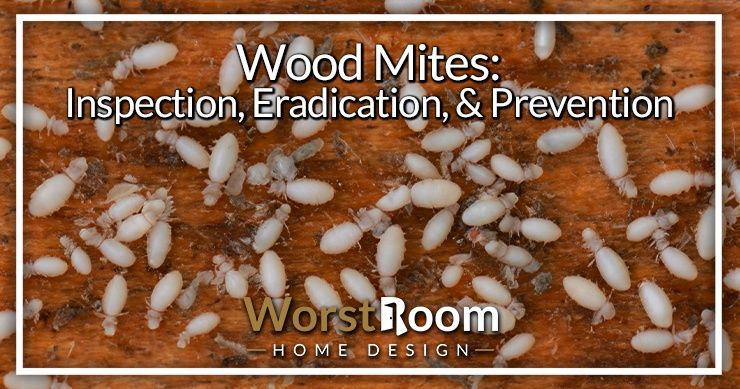
You may not see them, but they are there. Wood mites are sneaky little critters that can infest your home and munch on your wood. They may not pose a serious threat to your house, but they can certainly ruin your mood.
In this article, we will reveal the secrets of wood mites, from their appearance and habits to their causes and cures. You will also learn how to protect your home from these unwelcome guests and keep your wood in tip-top shape.
Understanding Wood Mites
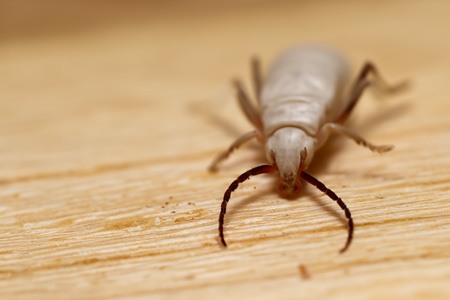
Wood mites are small white bugs with eight legs and a translucent white body, and they typically live on decomposing wood or woody material indoors while feeding on plants when living outdoors. If you see tiny white bugs on wood, they're very likely to be wood mites.
Appearance, Behavior, & Signs of Infestation
What do wood mites look like? Identifying wood mites in your home is the first step toward tackling an infestation. These small, white bugs are characterized by a translucent body and eight legs, often making them hard to spot against light-colored surfaces.
Recognizing the signs of wood mite infestation is crucial for timely intervention. They typically do not burrow into material but rather nestle in dust and debris found on decomposing wood or woody material indoors.
In outdoor settings, they might feast on plants near their habitat. Wood decay, dampness, and structural damage are ideal pest breeding grounds.
If you’re trying to identify them simply be the holes they create in wood, make sure you’re not dealing with termites, carpenter ants, or carpenter bees. We've catalogued 15 types of termites for you to check out to make sure you're not mistaken as well.
Common Causes of Infestation
One of the primary reasons for wood mite infestations is the presence of decay and dampness in a home's wooden furniture, fixtures, or structural elements. These tiny wood bugs thrive in moist environments where they can easily find food sources such as mold and mildew.
Another contributing factor to pest infestations can be poor moisture control within your living space. Leaks, condensation build-up, and inadequate ventilation all contribute to increased humidity levels that attract wood mites to your property.
Additionally, disruptions during construction work or renovation projects might introduce mite-infested materials into your house without you even realizing it.
How to Get Rid of Wood Mites
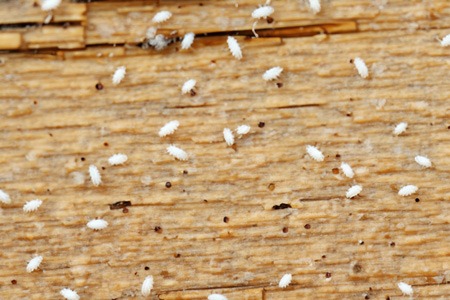
To effectively get rid of wood mites, you can remove infested wood, use a vacuum to eliminate mites and eggs, apply insecticides or natural remedies, or seek professional help as needed.
Removing & Disposing of Infested Wood
One of the most effective ways to eliminate a wood mite infestation is by removing and disposing of infested wood. This crucial step helps immediately reduce the population of these pesky pests and prevents further damage to your property.
When you come across an item that's severely infested with wood mites, it may be necessary to discard it altogether. Bag the affected pieces securely using heavy-duty garbage bags before disposing of them in designated waste disposal facilities.
Doing so will minimize the risk of spreading the mites elsewhere within your property. If an object has been moderately affected by these insects, consider freezing it, if possible, as a safe way to treat it without resorting to harsh chemicals.
Remember that proper cleanup measures are essential for keeping infestations at bay; vacuum thoroughly around areas where you've located any signs of activity and use anti-mite pesticide sprays available from home improvement stores as needed.
Lastly, Reclaim IT can be employed around access points in your property to ward off any new invaders coming in from outside.
Using a Vacuum To Remove Mites & Eggs
A vacuum is one of the most effective ways to eliminate wood mites from furniture and other household items. By thoroughly cleaning and removing dust from infested areas, you can prevent mites from breeding and spreading further.
When vacuuming, use a machine with strong suction power to reach into tight crevices where mites like to hide. The preferable type of vacuum for this job would be a shop vac with hose attachments.
It's important to note that simply vacuuming isn't always enough for severe infestations – you may need to dispose of heavily infested items altogether. However, regular vacuuming in combination with other methods such as insecticides or natural remedies can help keep wood mite populations under control.
Applying Insecticide or Natural Remedies
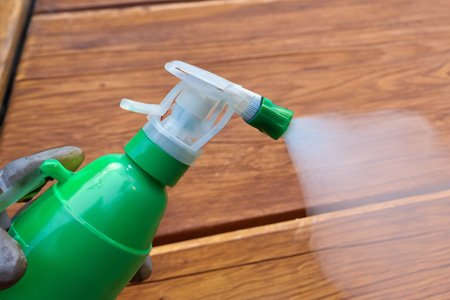
Applying insecticide or natural remedies can be an effective solution if you're dealing with a wood mite infestation. Anti-mite pesticide sprays are widely available at home and garden stores, and many options are designed to target specific types of mites.
Alternatively, there are also natural solutions that can help eradicate wood mites. One option is using predator mites, such as Hypoaspis miles, from online or garden supply stores.
These predatory insects feed on wood mites and can offer long-term control without the use of harsh chemicals. Regardless of your chosen method, keeping your home clean and debris-free is essential for preventing future infestations.
Seeking Professional Help as Needed
Sometimes, a wood mite infestation can become severe and difficult to manage on your own. This is where seeking professional help may be necessary. Pest control companies specialize in identifying the type of mite invading your home and the extent of the infestation.
However, before calling for professional help, try implementing preventative measures to minimize future occurrences. Regular cleaning techniques such as vacuuming or wiping down surfaces can go a long way in preventing further infestations.
Investing in moisture control products like dehumidifiers or proper ventilation systems will discourage mold growth and prevent structural damage due to excess dampness.
Wood Mite Prevention Tips
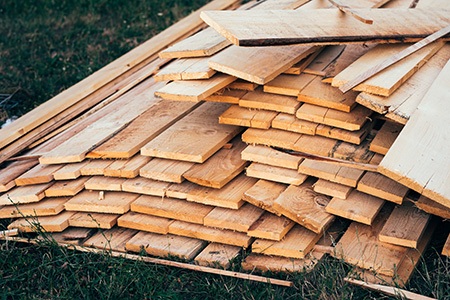
Preventing wood mite infestations can be achieved by properly storing firewood, monitoring moisture levels, sealing up cracks and crevices, and inspecting and treating incoming wood.
Properly Storing Firewood
Properly storing firewood is crucial in preventing wood mite infestations. Firewood should be kept off the ground and covered with a tarp to protect it from rain and snow.
Neat stacking can also prevent moisture build-up and allow for proper air circulation, which can deter wood mites from making their home in your firewood pile.
To further prevent wood mites, it's important to inspect incoming firewood for signs of infestation before bringing it indoors for use. If wood mites are present on the incoming load, treating them with an anti-mite pesticide spray can help control the problem.
Monitoring Moisture Levels
Moisture control is a key factor in preventing wood mite infestations. Wood mites are attracted to damp, old wood and other wood-based cluttered areas. It's important to monitor moisture levels in your home regularly to prevent structural damage, pest infestations, and wood mites.
Leaks or poorly insulated areas must be checked regularly as this will help resolve moisture issues that may attract pests like wood mites. Cleaning your home and neatness also play a crucial role in keeping these pests at bay.
Regular cleanings can eliminate dust where the mites hide or breed quickly. For instance, furniture can be vacuumed to remove any existing eggs or adult mites so they don't have a chance to reproduce inside the house.
Sealing Up Cracks & Crevices
Preventing a wood mite infestation starts by sealing cracks, crevices, and gaps around windows, doors, and pipes. These tiny pests can squeeze through even the tiniest openings, so ensuring everything is sealed correctly is important.
Caulking and weather-stripping are simple ways to seal off these entry points. Additionally, inspecting the exterior of your home for holes or gaps in the foundation can help keep these unwelcome guests out.
Properly storing firewood away from your home and raised off the ground also helps prevent an infestation from occurring.
Inspecting & Treating Incoming Wood
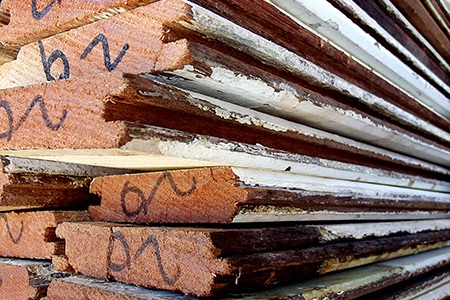
To prevent wood mite infestations, inspecting and treating the incoming wood before storing it is important. This is especially crucial for firewood, as mite eggs can easily be transported from one place to another.
Before bringing in any new logs, make sure to inspect them thoroughly for signs of infestation, such as small holes or sawdust on the surface.
To further minimize your risk of a mite invasion, consider treating your firewood with an anti-mite pesticide spray before storing it for long periods. These targeted pesticides can be found at local home and garden stores or online and are specifically designed to combat common pests like wood mites.
Remember that prevention is always better than cure when dealing with pesky creatures like wood mites.
That’s How to Get Rid of Wood Mites
Wood mites are pesky invaders that can ruin your wood and your mood. But don't worry; you can get rid of them for good with some simple steps, such as removing infested wood, vacuuming, using insecticides or natural remedies, and calling a pro if needed.
You can also prevent them from returning by storing your firewood properly and monitoring your moisture levels. By following these tips, you can protect your home from wood mites and enjoy your wood in peace.



